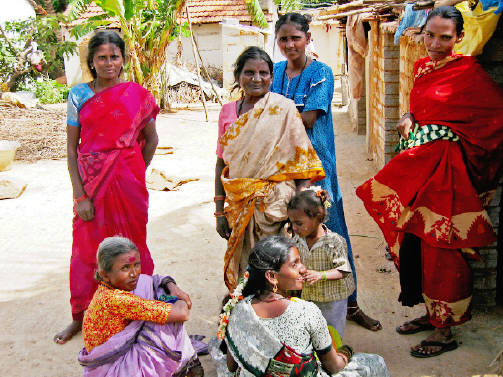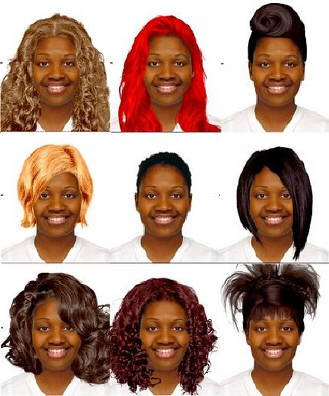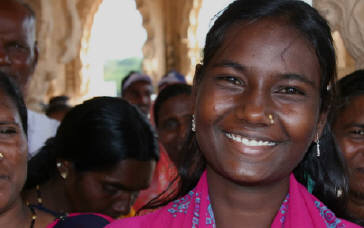









Who are the Dalits and About Straight hair?
The Dalits, also called the"Chandalas," “untouchables,” “outcastes,” "Dravidians" and most recently “slumdogs,” comprise nearly one quarter of India’s society, with population estimates of 250 million people. The term “Dalit” means “those who have been broken and ground down deliberately by those above them in the social hierarchy.” Dalits live at risk of discrimination, dehumanization, violence, and enslavement through human trafficking every day. By all global research and reports, the Dalits constitute the largest number of people categorized as victims of modern-day slavery. Black people in India represent the largest group of people outside of Africa in the world. The Africans were the orginal people of India thousands of years ago and an over 1000 year old fight happen and the Blacks lost and they started a caste system discrimination in India that has gone on for over 3000 years.
The Gosho “Attaining Buddhahood in Lifetime “reads: “Life at each moment encompasses the body and mind and the self and environment of all sentient beings in the Ten Worlds as well as all insentient beings in the three thousand realms, including plants, sky, earth, and even the minutest particles of dust. Life at each moment permeates the entire realm of phenomena and is revealed in all phenomena. To be awakened to this principle is itself the mutually inclusive relationship of life at each moment and all phenomena.
6. The next was the Armenoids, or Western Brachycephals, represent an offshoot of Alpine or European stock.
1
Hell
Physical or mental condition distress
2.
Hunger
desire
3.
Animality
or basic instinctual actions
4.
Anger
rage or passion to overtake
5.
Humanity
or tranquility peace or calm state
6.
Rapture
or heaven or Joy
7.
Learning
the condition of absorbing knowledge or adapting
8.
Self realization
or absorption in common term learning things by practice.
9.
Bodhisattva
is our compassionate or loving protecting nature or condition
10.
Buddha hood
is our highest life condition or enlightenment state.
Buddhism teaches that all phenomena manifest the “TEN WORLD.S”
-
(1) The realm of the five components: An analysis of the nature of a living entity in terms of how it responds to its surroundings. The five components are form, perception, conception, volition, and consciousness. Form includes everything that constitutes the body and its sense organs, through which one perceives the outer world. Perception means the function of receiving or apprehending external information through one's sense organs. Conception indicates the function by which one grasps and forms some idea or concept about what has been perceived. Volition means the will to initiate action following the creation of conceptions about what has been perceived. Consciousness is the cognitive function of discernment that integrates the components of perception, conception, and volition. It distinguishes an object from all others, recognizes its characteristics, and exercises value judgments, such as distinguishing between right and wrong. From another viewpoint, while consciousness is regarded as the mind itself, the components of perception, conception, and volition are regarded as mental functions. Form corresponds to the physical aspect of life, and the other four components, to the spiritual aspect. The principle of the five components explains how life expresses each of the Ten Worlds differently. Someone in the world of hell, for example, will perceive, form a conception of, and react to the same object in a completely different manner than someone in the world of bodhisattvas.
(2) The realm of living beings: The individual living being, formed of a temporary union of the five components, who manifests or experiences any of the Ten Worlds. The realm of living beings refers to an individual as an integrated whole, but since no living being exists in perfect isolation, it is also taken to mean the collective body of individuals who interact with one another.
(3) The realm of the environment: The place or land where living beings dwell and carry out life-activities. The state of the land is a reflection of the state of life of the people who live in it. A land manifests any of the Ten Worlds according to which of the Ten Worlds dominate in the lives of its inhabitants. The same land also manifests different worlds for different individuals. Therefore, Nichiren says, "There are not two lands, pure or impure in themselves. The difference lies solely in the good or evil of our minds" (4). In making this statement, Nichiren was coun-tering the popular view that there are separately existing impure lands and pure lands.In addition, the three realms themselves are not to be viewed separately, but as aspects of an integrated whole, which simultaneously manifests any of the Ten Worlds.